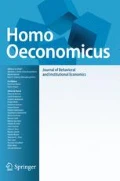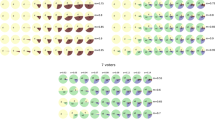Abstract
Representatives from differently sized constituencies form an assembly which takes political decisions by a weighted voting rule and adopts the ideal point of the weighted median amongst them. Preferences of each representative are supposed to coincide with the constituency’s median voter. Analytic results by Kurz et al. (J Polit Econ, 2017) for infinite chains of assemblies suggest that individual voters’ a priori influence on the collective decision can be equalized by allocating voting weight proportional to the square root of constituency sizes. This paper investigates numerically the performance of this simple square root rule and sophisticated variations, based on the Shapley value or the Penrose–Banzhaf power measure, when the number of constituencies is still “small”. Monte Carlo simulations indicate that power index-based rules are superior to simple rules.


Similar content being viewed by others
Notes
The treaty defined voting weights and a quota. The Nice rules could be invoked in the EU until March 2017, when they were eventually replaced by the ‘double majority’ voting system agreed in the Treaty of Lisbon.
Under the assumption that top-tier voters are stochastically identical the model would lead to a linear rule based on the Shapley–Shubik index. Note, however, that this assumption would be generally inconsistent with bottom-tier voters being stochastically identical.
See Banks and Duggan (2000) for sophisticated non-cooperative support of policy outcomes inside or close to the core.
Kurz et al.’s model also allows preferences within constituencies to be positively correlated, which leads them to different conclusions regarding the optimal rule for equal representation. Here, we consider their model without such correlations.
For instance, there are only 117 structurally different weighted voting games with \(m=5\) constituencies even if all majority thresholds between 0 and 100% are permitted. This number (related to Dedekind’s problem in discrete mathematics) grows very fast, but obviously the set of distinct feasible influence distributions remains finite.
A MATLAB computer program is used for all computations. The source code is available upon request.
Generally, \(\alpha = 0.5\) is not exactly the best exponent among all power laws. Obviously, the best power law weights \(w_j = n_j^{\alpha ^{*}}\) for a given configuration result in a lower deviation from egalitarian representation than simple square root weights, but they turn out to perform still significantly worse than \(w_\beta\) and \(w_\phi\).
References
Alon, N., & Edelman, P. H. (2010). The inverse Banzhaf problem. Social Choice and Welfare 34(3), 371–377.
Avriel, M. (1976). Nonlinear programming: Analysis and methods. Englewood Cliffs: Prentice-Hall.
Aziz, H., Paterson, M., & Leech, D. (2007). Effcient algorithm for designing weighted voting games. In Multitopic Conference, 2007. INMIC 2007 (p. 16). IEEE International. http://eprints.dcs.warwick.ac.uk/1547/.
Banks, J. S., & Duggan, J. (2000). A bargaining model of social choice. American Political Science Review, 94(1), 73–88.
Barberà, S., & Jackson, M. O. (2006). On the weights of nations: Assigning voting weights in a heterogeneous union. Journal of Political Economy, 114(2), 317–339.
Beisbart, C., & Bovens, L. (2007). Welfarist evaluations of decision rules for boards of representatives. Social Choice and Welfare, 29(4), 581–608.
Beisbart, C. & Hartmann, S. (2006). Welfarism and the assessment of social decision rules. In U. Endriss & J. Lang (Eds.), Computational Social Choice 2006 (p. 35–48). Amsterdam.
Chang, P.-L., Chua, V. C., & Machover, M. (2006). L S Penrose’s Limit Theorem: Tests by simulation. Mathematical Social Sciences, 51(1), 90–106.
Felsenthal, D., & Machover, M. (1999). Minimizing the mean majority deficit: The second square-root rule. Mathematical Social Sciences, 37(1), 25–37.
Holler, M. (1982). Forming coalitions and measuring voting power. Political Studies, 30(2), 262–271.
Koriyama, Y., Laslier, J.-F., Macé, A., & Treibich, R. (2013). Optimal apportionment. Journal of Political Economy, 121(3), 584–608.
Kurz, S. (2016). The inverse problem for power distributions in committees. Social Choice and Welfare, 47(1), 65–88.
Kurz, S., Maaser, N., & Napel, S. (2017). On the democratic weights of nations. Journal of Political Economy (forthcoming).
Kurz, S., & Napel, S. (2014). Heuristic and exact solutions to the inverse power index problem for small voting bodies. Annals of Operations Research, 215(1), 137–163.
Laruelle, A., & Widgrén, M. (1998). Is the allocation of power among EU states fair? Public Choice 94(3–4), 317–340.
Leech, D. (2002a). Designing the voting system for the EU Council of Ministers. Public Choice, 113(3–4), 437–464.
Leech, D. (2002b). Voting power in the governance of the International Monetary Fund. Annals of Operations Research, 109(1), 375397.
Leech, D. (2003). Power indices as an aid to institutional design: The generalised apportionment problem. In M. J. Holler, H. Kliemt, D. Schmidtchen, & M. E. Streit (Eds.), Jahrbuch für Neue Politische Ökonomie (Vol. 22, pp. 107–121). Tübingen: Mohr Siebeck.
Lindner, I., & Machover, M. (2004). L. S. Penrose’s Limit Theorem: Proof of some special cases. Mathematical Social Sciences, 47, 37–49.
Lindner, I., & Owen, G. (2007). Cases where the Penrose limit theorem does not hold. Mathematical Social Sciences, 53(3), 232–238.
Maaser, N., & Napel, S. (2007). Equal Representation in Two-tier Voting Systems. Social Choice and Welfare, 28(3), 401–420.
Neyman, A. (1982). Renewal theory for sampling without replacement. Annals of Probability, 10(2), 464–481.
Penrose, L. S. (1946). The elementary statistics of majority voting. Journal of the Royal Statistical Society, 109, 53–57.
Penrose, L. S. (1952). On the objective study of crowd behaviour. London: H. K. Lewis & Co.
Shapley, L. S. (1953). A value for \(n\)-person games. In H. W. Kuhn & A. W. Tucker (Eds.), Contributions to the Theory of Games (Vol. II, pp. 307–317). Princeton: Princeton University Press.
Shapley, L. S., & Shubik, M. (1954). A method for evaluating the distribution of power in a committee system. American Political Science Review, 48(3), 787–792.
Weber, M. (2016). Two-tier voting: Measuring inequality and specifying the inverse power problem. Mathematical Social Sciences, 79(3), 40–45.
Author information
Authors and Affiliations
Corresponding author
Additional information
The paper has benefitted from critical comments and suggestions from three anonymous referees, and participants at the 5th World Congress of the Game Theory Society in Maastricht.
Rights and permissions
About this article
Cite this article
Maaser, N. Simple vs. Sophisticated Rules for the Allocation of Voting Weights. Homo Oecon 34, 67–78 (2017). https://doi.org/10.1007/s41412-017-0036-5
Received:
Accepted:
Published:
Issue Date:
DOI: https://doi.org/10.1007/s41412-017-0036-5




